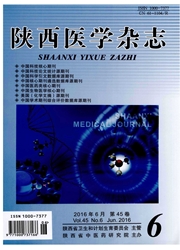

 中文摘要:
中文摘要:
目的:探讨黄芩苷对ApoE基因敲除小鼠早期动脉粥样斑块中基质金属蛋白酶-9(MMP-9)表达的影响。方法:24只8周龄ApoE-/-小鼠均给予高脂饲料喂养8周后随机分为对照组、苷低剂量和高剂量组,每组8只。灌胃8周后处死,酶法检测血清甘油三酯(TG)、总胆固醇(TC)、低密度脂蛋白胆固醇(LDL-C)和高密度脂蛋白胆固醇(HDL-C)浓度;用ELISA测血清中MMP-9的表达水平;通过RT-PCR和Western blot检测小鼠主动脉斑块组织中MMP-9的表达情况。结果:与对照组相比,干预组小鼠血清中TC水平降低(P〈0.05),血清中LDL-C水平明显降低(P〈0.01),高剂量组较低剂量组降低的明显(P〈0.05);各组小鼠血清中HDL-C及TG含量虽有变化但无统计学意义。黄芩苷干预组血清MMP-9较对照组表达水平低,高剂量组降低更显著(P〈0.05);同时,黄芩苷干预组主动脉斑块中MMP-9mRNA及蛋白水平较对照组降低明显(P〈0.01),高剂量组降低尤为显著(P〈0.05)。结论:黄芩苷可以降低ApoE-/-小鼠血清中血脂和MMP-9水平,并可降低动脉粥样硬化斑块中MMP-9表达,提示黄芩苷具有稳定动脉粥样硬化斑块作用。
 英文摘要:
英文摘要:
Objective:To explore the effects of Baicalin on the expression of MMP-9at early stage of atherosclerosis in apolipoprotein E knockout mice(ApoE-/-).Methods:Male 8-week-old ApoE-/-mice fed with high fat diet for 8weeks were randomly divided into three groups(n=8each):control group,low-dose Baicalin treated group,high-dose Baicalin treated group.All the animals were fed for 8weeks.After administered for 8weeks,mice were sacrificed.serum TG、TC、LDL-C and HDL-C was measured.The serum MMP-9concentration was measured by ELISA.The expression of aortic MMP-9 mRNA and protein in each group mice were determined by Real-time PCR and Western blot respectively.Results:Compared with control group,serum TC level in Baicalin treated groups were reduced(P〈0.05),serum LDL-C level in Baicalin treated groups were reduced obviously(P〈0.01),especially in high-dose Baicalin(P 0.05),but The serum TG、HDL-C level did not have significant differences between groups.The level of serum MMP-9in the Baicalin treated groups was lower than that in the control group,significantly in high-dose Baicalin(P〈0.05).Meanwhile,the expression of aortic MMP-9mRNA and protein detected by Real-time PCR and Western blot,decreased in Baicalin treated groups compared with that in control group(P 0.01),which in the high-dose Baicalin treated group were reduced more(P 0.05).Conclusion:The serum level of Lipids and MMP-9in ApoE-/-mice and the expression of MMP-9in aortic atherosclerotic plaque are reduced by Baicalin,which it shows has regulation function on stability of the plaque.
 同期刊论文项目
同期刊论文项目
 同项目期刊论文
同项目期刊论文
 期刊信息
期刊信息
